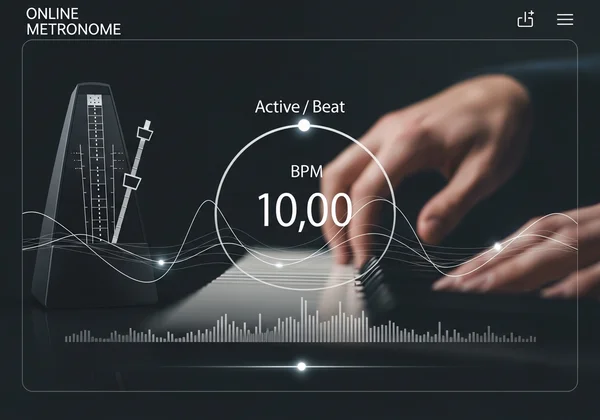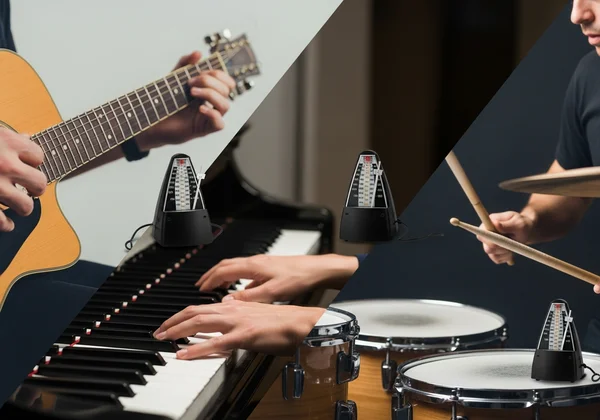Metronome Exercises: Your Ultimate Rhythm Practice Hub
Rhythm is the heartbeat of music, the fundamental pulse that gives life to every melody and harmony. Yet, for many musicians, developing a rock-solid sense of time is a lifelong challenge. Are you looking to sharpen your timing, master complex rhythms, and play with unshakable confidence? This is where dedicated Metronome Exercises become your greatest ally. How can a metronome improve my playing? By providing an unwavering, objective reference point, a metronome online transforms abstract rhythmic concepts into tangible skills, building muscle memory and internalizing a precise sense of time.
This comprehensive guide is your central resource for rhythm development. We will explore everything from foundational timing drills to advanced polyrhythmic workouts. Whether you're a beginner finding your footing or a seasoned pro pushing your limits, the exercises here will elevate your musicianship. The best part? You can start practicing immediately with our powerful metronome online, which is a completely free online tool.

What You'll Discover in This Metronome Exercise Library
Inside this guide, you’ll find structured exercises designed to systematically improve your rhythmic accuracy. We cover foundational skills, instrument-specific workouts, advanced subdivision challenges, and genre-specific grooves. Get ready to turn your metronome from a simple timekeeper into your personal rhythm coach.
Metronome Training Essentials: Building Your Foundational Timing Skills
Every great musical performance is built on a solid rhythmic foundation. Before tackling complex passages, you must first master the art of playing perfectly in time. This section focuses on the core principles of metronome training, helping you develop an internal clock that is both steady and reliable. These fundamental drills are the building blocks for all future progress.

Starting Strong: How to Use a Metronome for Beginners
If you're new to using a metronome, the constant clicking can feel more like a distraction than a guide. The key is to start simple. First, set the metronome to a slow, comfortable tempo, like 60 BPM (beats per minute). Your only goal is to clap your hands or play a single note precisely on each click. Listen carefully, aiming to make your sound merge with the metronome's pulse until they are indistinguishable. This simple exercise builds the crucial connection between what you hear and what you do.
Finding Your Groove: What is a Good Tempo for Practice?
A common mistake is practicing too fast, too soon. The ideal practice tempo is the speed at which you can play a passage perfectly without any mistakes. If you’re stumbling, you’re going too fast. Use the "Tap Tempo" feature on our online metronome to find the tempo of a song you're learning, then set the BPM about 10-20% slower. Master the piece at this slower speed, then gradually increase the tempo by 2-4 BPM at a time. This methodical approach ensures you build accuracy, not just sloppy speed.
Core Rhythm Drills for Consistent Pulse
To truly internalize rhythm, you need to feel the space between the beats. Set your metronome to 70 BPM. First, play a note on every click (quarter notes). After a minute, switch to playing a note on beats 1 and 3 only (half notes). Finally, try playing a single note only on beat 1 of each four-beat measure (whole notes). This exercise forces you to count and feel the empty space, dramatically improving your internal sense of time. This is a foundational step in your rhythm practice journey.
Instrument-Specific Practice with Metronome: Tailored Workouts
While the principles of rhythm are universal, every instrument presents unique challenges. Tailoring your practice with metronome to your specific instrument allows you to target technical hurdles like finger dexterity, bowing consistency, or limb independence. These focused workouts will directly translate to cleaner, more professional-sounding performances.

Metronome for Guitarists: Sharpening Speed & Accuracy
For guitar players, a metronome is essential for building speed and precision in scale runs and arpeggios. Start by setting a slow tempo and playing a simple C major scale using only downstrokes, one note per click. Once that feels solid, play the scale again using strict alternate picking. This drill ensures that both your fretting and picking hands are perfectly synchronized. You can try this right now using our customizable metronome.
Piano Metronome Exercises: Enhancing Coordination & Flow
Pianists constantly battle to achieve perfect hand independence and evenness of touch. A great exercise is to play a simple five-finger scale (C-D-E-F-G) with your right hand, one note per click. While the right hand continues, bring in your left hand to play the same pattern, but starting two beats later. This drill is challenging at first but works wonders for developing the coordination needed for complex contrapuntal music like Bach.
Drum Metronome Practice: Mastering Groove & Precision
For drummers, timing isn't just part of the music—it is the music. A foundational exercise is the single-stroke roll. Set your metronome and play alternating strokes on your snare drum, starting with quarter notes (one hit per click). Then, progress to eighth notes (two hits per click), and finally sixteenth notes (four hits per click). The goal is absolute evenness between your hands. Our metronome tool provides clear visual cues to help you stay locked in.
Advanced Rhythm Practice Exercises: Unlocking Complex Subdivisions
Once you've mastered the basics, it's time to explore the intricate world of advanced rhythms. This is where a highly customizable metronome online becomes indispensable. These advanced rhythm practice exercises will push your abilities, enabling you to tackle sophisticated musical genres and compositions with confidence and flair.

Mastering Complex Time Signatures (5/4, 7/8, etc.)
Music isn't always in 4/4. To master complex time signatures, use your metronome's accent feature. For 5/4 time (like the famous "Take Five"), set the metronome to 5 beats per measure with a strong accent on beat 1. Clap or play a note on each beat to feel the unique "3+2" or "2+3" pulse. For 7/8, you can set the accent to group the beats into patterns like "2+2+3" to internalize its distinctive feel.
Exploring Metronome Subdivisions: Triplets, Sixteenths, and Beyond
True rhythmic mastery lies in understanding the space between the main beats. Use our online tool's subdivision feature to practice this. Set the BPM to 60. First, play quarter notes. Then, switch the subdivision setting to eighth notes and play two even notes for every click. Next, select sixteenths and play four even notes per click. Finally, tackle triplets, fitting three perfectly even notes into the space of one beat. This will give your playing a more fluid and professional sound.
Polyrhythm Training with Your Online Metronome
Polyrhythms involve playing two different rhythmic patterns simultaneously, like three notes against two. This is an advanced but highly rewarding skill. Set your metronome to a slow tempo. Tap a "two" pattern with your right hand (e.g., on beats 1 and 3 of a 4/4 measure) and a "three" pattern with your left hand (e.g., an eighth-note triplet starting on beat 1). It helps to say a mnemonic phrase like "Not Difficult" to feel the rhythm. This is a true test of your internal clock.
Genre-Specific Metronome Drills for Enhanced Music Timing & Feel
Rhythm is the soul of every musical genre, from the driving pulse of rock to the syncopated swing of jazz. Applying your metronome skills to specific styles helps you move beyond mechanical accuracy to develop an authentic musical feel. These drills will improve your overall music timing exercises by putting them into a real-world context.

Funk Guitar Rhythm Practice: The Groove Imperative
Funk music is all about the sixteenth-note groove. Set your metronome to 80 BPM and enable the sixteenth-note subdivision. Your goal is to create a rhythmic pattern by muting most of the strings but letting one or two notes ring out on specific off-beats. Focus on locking your strumming hand in with the metronome's subdivision clicks. This will help you develop the tight, percussive feel that is the essence of funk.
Latin Rhythm Practice: Clave, Tumbao, and Montuno Foundation
Latin music is built around a rhythmic key called the clave. To practice the 3-2 son clave, set your metronome to 100 BPM. Clap the "three" side in the first measure (on beats 1, the "&" of 2, and 4) and the "two" side in the second measure (on beats 2 and 3). Looping this pattern over the steady click of the BPM counter helps internalize one of the most important rhythmic patterns in world music.
Jazz Swing Feel Metronome Exercises
To develop a convincing jazz swing feel, stop thinking about the clicks as beats 1, 2, 3, and 4. Instead, think of them as beats 2 and 4. Set your metronome to 120 BPM. Now, snap your fingers or play a chord on beats 2 and 4 along with the click. Let beat 1 and 3 be silent. This forces you to feel the "backbeat" and develop the laid-back, forward-moving pulse that defines swing.
Your Journey to Masterful Rhythm Practice Starts Now
From establishing a foundational pulse to mastering complex polyrhythms and genre-specific feels, you now have a comprehensive roadmap for your rhythmic development. Remember, the key to internalizing these skills is consistent, focused practice. Each exercise in this guide is a step toward making rhythm an intuitive part of your musical expression.
The most powerful tool for this journey is a reliable, versatile, and accessible metronome. Our online metronome is designed to handle every one of these exercises, from simple timekeeping to complex subdivisions and time signatures. Stop letting rhythm be a source of anxiety and start making it your greatest strength. Head over to our free online metronome and begin your practice today!
Frequently Asked Questions About Metronome Exercises
What is a good tempo for practice?
The best tempo is one where you can play the music perfectly without mistakes. For beginners, starting between 60-80 BPM is ideal for building muscle memory correctly. For advanced players working on speed, the goal is to find your maximum clean tempo and then push it slightly higher in each session.
How do beginners use a metronome effectively for rhythm exercises?
Beginners should focus on synchronizing with the beat. Start by just clapping on each click. Then, play a single note on your instrument with each click. The goal is to make your sound disappear into the metronome's click. This builds the fundamental skill of listening while playing. Using our simple free metronome is a great way to start.
How can consistent metronome exercises improve my playing and overall music timing?
Consistency is key. Regular practice with a metronome re-wires your brain and muscles to understand time accurately. It exposes timing flaws you might not hear otherwise, cleans up your technique, and allows you to play more confidently with other musicians. Over time, you develop a reliable "internal clock."
Why are rhythm subdivisions crucial for effective metronome practice?
Music rarely happens only on the main beats. Subdivisions (like eighths, sixteenths, or triplets) are the notes that happen between the clicks. Practicing them develops a sophisticated sense of rhythm, improves your groove, and is essential for playing genres like funk, jazz, and R&B authentically. A metronome online that audibly plays the subdivisions is invaluable for this.
Are there specific metronome exercises for different instruments like guitar, piano, or drums?
Absolutely. As we've shown, while the core principles are the same, the application differs. Guitarists might focus on alternate picking, pianists on hand independence, and drummers on limb coordination. The exercises in this guide provide a great starting point, and you can adapt them to any technical challenge you face on your instrument. The first step is to start practicing with a reliable click.